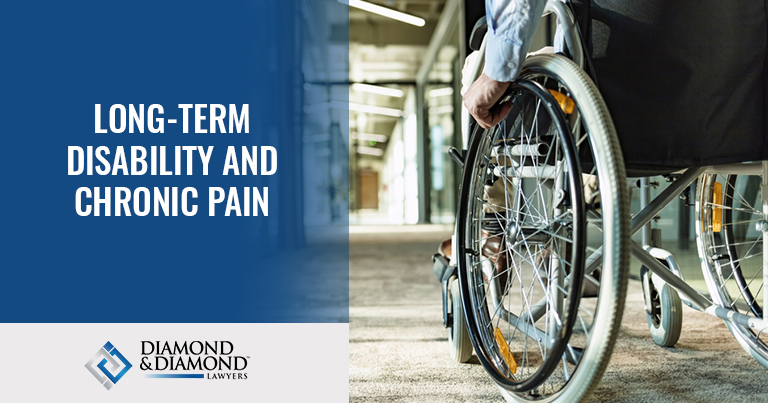Chronic pain patients understand that pain isn’t their sole issue. Pain might make it difficult to exercise, care for your house and family, and, most significantly, work. These pain-related restrictions are a part of the suffering, and there is no simple method to quantify your pain experience.
This may cause you to be concerned that you may not obtain time off work or disability benefits due to your chronic pain. You can apply for long-term disability payments if you’re an employee who cannot work due to discomfort. If you want to fight for your cause, these are the first things you should study.
Understanding Chronic Pain
Chronic pain is commonly characterized as pain that lasts longer than usual following a severe sickness or accident, usually more than three to six months. Chronic pain can be localized, affecting only one body region, such as the head, back, or joints. Chronic pain patients, on the other hand, may have muscular or nerve discomfort throughout their bodies.
The pain might be caused by an accident or sickness or for no apparent reason. In these situations, patients and their doctors may experience irritation and worry as they try to discover difficult solutions.
What Are The Causes of Chronic Pain?
Chronic pain is increasingly being recognized as a complicated and severe condition that can result in substantial impairment. The following are some of the most prevalent medical problems that chronic pain syndromes can be associated with:
Fibromyalgia
Fibromyalgia is frequently associated with tiredness, as well as changes in sleep, memory, and mood. The most frequent symptoms are widespread muscular soreness and tenderness. Medications, talk therapy, and stress reduction may all aid with symptom management.
Rheumatoid Arthritis
Many joints, particularly those in the hands and feet, are affected by this chronic inflammatory disease. The body’s immune system destroys its tissue, including joints, in rheumatoid arthritis. Internal organs are attacked in extreme instances. The linings of joints are affected by rheumatoid arthritis, which causes painful swelling.
The inflammation associated with rheumatoid arthritis can lead to bone degradation and joint deformities over time. Rheumatoid arthritis has no cure, although physiotherapy and medicines can help reduce the disease’s development and progression. Anti-rheumatic medicines are a family of pharmaceuticals that can be used to treat most instances.
Diabetes
Diabetes is a disorder in which your blood glucose level is excessively high, also known as blood sugar. Blood glucose, which originates from the food you eat, is your primary source of energy. Insulin, a pancreatic hormone, facilitates glucose absorption into cells for utilization as energy. Those who have diabetes can develop diabetic neuropathy or nerve pain. This can be a chronic and debilitating condition.
Endometriosis in Women
Endometriosis occurs when tissue that is comparable to the uterine lining develops outside of the uterus. More than 11% of women aged 15 to 44 may be affected. It’s more frequent among women in their 30s and 40s, can make getting pregnant more complex, and can cause significant pain.
Irritable Bowel Syndrome
Stomach discomfort, wind, diarrhea, and constipation are all symptoms of an intestinal disease. The exact etiology of irritable bowel syndrome is unknown. Symptoms are frequently used to make a diagnosis. Abdominal discomfort, bloating, diarrhea, and constipation are some of the symptoms. Diet, lifestyle, and stress management can help some people manage their symptoms. Others will require medicine as well as counseling.
Chronic Headaches or Migraines
For more than three months, chronic migraine is defined as having at least 15 headache days per month, with at least eight days of headaches with migraine characteristics. Chronic headaches start as less frequent headache episodes that progress to a more regular headache pattern over time.
Back Pain
Chronic back pain is generally caused by aging, although a previous injury can also be a cause. The following are the most prevalent causes: The progressive weakening of the cartilage inside the spine is known as spine arthritis. The narrowing of the spinal canal, which can cause nerve discomfort, is known as spinal stenosis.
How Does Long-Term Disability Work?
 Chronic pain can make it challenging to work in any environment. If you work in a physically demanding profession, chronic pain might restrict your ability to carry items and move around. If you work in a sedentary position, chronic pain can limit your ability to remain at a computer for long periods.
Chronic pain can make it challenging to work in any environment. If you work in a physically demanding profession, chronic pain might restrict your ability to carry items and move around. If you work in a sedentary position, chronic pain can limit your ability to remain at a computer for long periods.
If you can’t work due to your disability, your long-term disability payments will help you financially during this trying period. When your disease becomes so severe that you cannot return to work, income replacement is required. Long-term disability insurance benefits, whether individual or group coverage, will provide financial assistance until you can return to employment for which you are qualified, trained, or have experience.
Chronic pain and long-term disability can lead to emotional and psychological illness, as the lack of functionality and persistent pain leads to anguish and psychological distress. A Diamond and Diamond long-term disability lawyer can assist you in receiving the compensation you deserve.
How to Make a Successful Long-Term Disability Claim for Chronic Pain?
When you’re trying to file a successful insurance claim for long-term disability benefits for chronic pain, there are a few things to keep in mind. Here are a few pointers for filing a successful LTD claim for chronic pain.
Establish Credibility
You’ll need more than just a doctor’s letter to get started. You must show that you have obtained medical advice from qualified professionals and are seeking treatment. Credibility can be established by proving that you have undergone medical testing to determine the reason for your discomfort, in whatever manner your doctor advises.
Follow Your Doctor’s Treatment Instructions
It’s critical to follow your doctor’s instructions. Consult a certified chronic pain expert, as well as any additional specialists indicated by your primary practitioner. The courts will reward claimants who pursue therapy for their impairments regularly and actively.
Make Sure You Are Comprehensive and Truthful
Your doctor will need to confirm that your symptoms are keeping you from functioning. Do not exaggerate your symptoms while telling your doctor about them. If you’ve had any trauma or an incident such as a fall, make sure to describe it in full. You should include as much information as possible regarding your illness and how it affects your capacity to work.
Include Any Necessary Documentation
Gather the necessary information for your LTD claim:
- Statements from Doctors
- A Formal Prognosis
- Accident Reports and Test Findings
- Statements of Witnesses
- Records of Medical Care
Get In Touch With The Experienced Personal Injury Lawyers At Diamond & Diamond
Have you or a family member been in an accident that has left you with chronic pain? You may require the services of a specialist personal injury lawyer that works in the subject and knows everything there is to know about it.
While getting injured can be a traumatic event, Diamond & Diamond personal injury attorneys will battle the insurance company and ensure that you have the best counsel possible. Our personal injury attorneys will also assist you in obtaining the money you are entitled to. For a free consultation, call 1-800-567-HURT now.
A rheumatologist or a physician with experience examining patients using various diagnostic approaches may be able to help if chronic pain is present.
Pro Tip: Long-Term Disability and Chronic Pain














